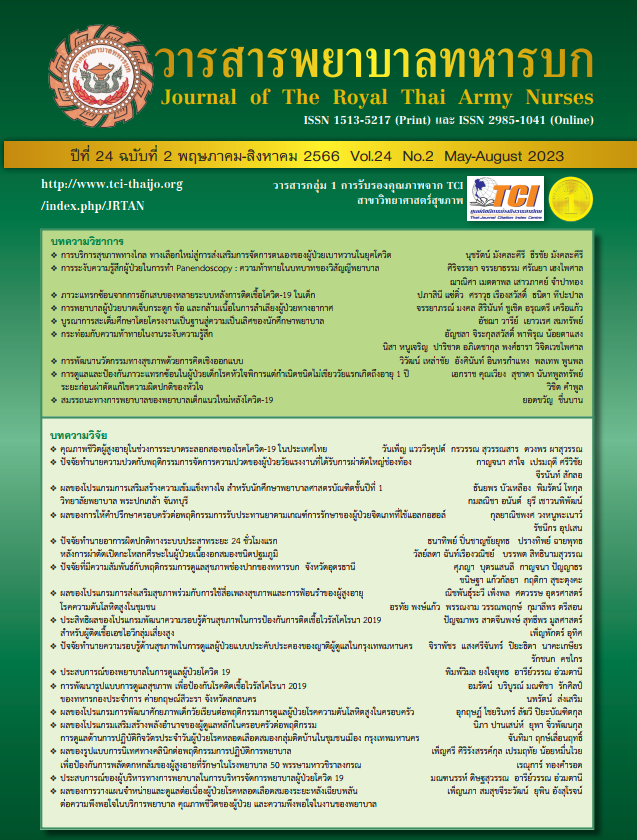Anesthesia for Panendoscopy : The Challenging Role of Nurse Anesthetist
Keywords:
Panendoscopy, Anesthesia, The Challenging Role of Nurse AnesthetistAbstract
Panendoscopy is a diagnostic procedure in uncertain malignancy patients according to head and neck lesions. Steps by steps direct visualization and tissue biopsy would be performed to identify the origin and stage of malignancy. Anesthetic management of the procedure can be challenging due to stenotic airway, concurrent airway sharing among surgeons and anesthesiologists. Airway management, detection, and treatment of intraoperative airway obstruction and desaturation are crucial. An expert nurse anesthetist is essential for patient care. The role of a nurse anesthetist is highly demanding, physically evaluated and mentally prepared during the preoperative visit, room set up with medication and specialized equipment, cooperating with the anesthesiologist during the procedure and handing over the patient to the postanesthetic care unit, and early detection of any postoperative complications, aiming for the best perioperative outcome for the patients.
Downloads
References
Valentin A, Goetz M, Hetzel J, et al. Routine panendoscopy in oral squamous cell cancer patients: mandatory or facultative?. Clinical Oral Investigations Journal. 2021;25(3): 1245-54.
Pincet L, Sandre C, Lang FJW, Colin V. Oncologic Panendoscopy: Description of an Optimized Procedure Based on Our Experience. International Archives of Otorhinolaryngology. 2022;26(1): 125-31.
Ellard L, Wong DT.Anesthesia for airway panendoscopy. In Abdelmalak B, Doyle DJ, editors. Anesthesia for otolaryngologic surgery.1st ed.New York:Cambridge University Press; 2013: 228-36.
Apfelbaum JL, Silverstien JH, Chung FF, et al. Practice guidelines for postanesthetic care: an updated report by the American Society of Anesthesiologists Task Force on Postanesthetic Care. Anesthesiology. 2013; 118:291-307.
Eissner F, Haymerle G, Brunner M. Risk factors for acute unplanned tracheostomy during panendoscopy in HNSCC patients. Public Library of Science Journal. 2018;13(12): e0207171.
Wong P, Wong J, Mok MU. Anesthesia management of acute airway obstruction. Singapore Medical Journal. 2016;57: 110-7.
Patel A. Anethesia for Otolaryngologic and Head-Neck surgery. In: Gropper MA, editor. Miller’s anesthesia. 9th ed. Philadelphia: Elsevier; 2020: 2010-35.
Apfelbaum JL, Hagberg CA, Connis RT, et al. 2022 American Society of Anesthesiologists Practice Guidelines for Management of the Difficult Airway. Anesthesiology. 2022;136(1): 31-81.
Mantaga S, Nithiutha J. Acute Airway Obstruction Management in Patients with Ear Nose Throat Problems. Thai Journal of Anesthesiology. 2021;47(3): 271-9. (in Thai)
Chaikham R, Raksanaves L, Pichaya N, et al. Abstract: Factors Predicting Nutritional Behaviors among Patients with Head and Neck Cancer at Chonburi Cancer Hospital. Journal of the Department of Medical Services. 2021;43(6): 68-73.
Tareerath M, Chumpathong S. Anesthesia for Patients with Tracheobronchial Stenosis: Role of Nurse Anesthetist. Journal of The Royal Thai Army Nurses. 2022;23(1): 33-40. (in Thai)
Hamour AF, Laliberte F, Levy J, et al. Overprescription of opioid analgesia is common following ambulatory Otolaryngology-Head and Neck surgery procedures: A multicenter study. World Journal of Otorhinolaryngology – Head and Neck Surgery. 2022;8(2): 145-51.
Johnson Pa, Ganapathy A, Narasimhan R. New Order of the Ages: Anesthesia in Bronchoscopy–Current Clinical Practice. Journal of Association of Pulmonologist of Tamil Nadu. 2020;3(3): 128-32.
Kim TK, Obara S, Johnson KB. Basic principles of pharmacology. In: Gropper MA, editor. Miller’s anesthesia. 9th ed. Philadelphia: Elsevier; 2020: 462-570.
Doyle DJ. Anesthesia for ear, nose, and throat surgery. In: Miller RD, editor. Miller’s anesthesia. 8th ed. Philadelphia: Elsevier; 2015: 2523-49.
Rudlof B, Hohenhorst W. Use of Apneic Oxygenation for the Performance of Panendoscopy. American Academy of Otolaryngology-Head and Neck Surgery Foundation. 2013;149(2): 235–9.
Artime CA, Hagberg CA. Airway management in adult. In: Gropper MA, editor. Miller’s anesthesia. 9th ed. Philadelphia: Elsevier; 2020: 1370-412.
Shahangian A, Damrose E, Bronchoscopy in Panendoscopy: Review and assessment. The Journal of Laryngology and Otology. 2015; 129(12): 1220-3.
Juang J, Cordoba M, Ciaramella A, et al. Incidence of airway complications associated with deep extubation in adults. BioMed Central Anesthesiology. 2020;20(1): 274-82.
Saardwai P, Wivatvanit S. The Development of Nurse Anesthetists’Competency Assessment Scale, Phramongkutklao Hospital. Journal of The Royal Thai Army Nurses.2019;20(2): 123-30. (in Thai)
Dejarkom S, Wangdee A, Jirakulsawat. Nursing Care in the post anesthesia care unit. Thai Journal of Anesthesiology.2014; 40(1): 46-52. (in Thai)
Aldrete JA. The post-anesthesia recovery score revisited. Journal of Clinical Anesthesia. 1995; 7 :89-91. 23.Suton P, Pongraweewan O.Postoperative Round. Thai Journal of Anesthesiology. 2020; 46(2): 119-24. (in Thai)
Palumbo P, Tellan G, Perotti B, et al. Modified PADSS (Post Anesthesia Discharge Score System) for monitoring outpatient discharge: Annali Italiani di Chirurgia Journal. 2013;84(6): 661-5.
Downloads
Published
How to Cite
Issue
Section
License
Copyright (c) 2023 Journal of The Royal Thai Army Nurses

This work is licensed under a Creative Commons Attribution-NonCommercial-NoDerivatives 4.0 International License.
บทความหรือข้อคิดเห็นใดใดที่ปรากฏในวารสารพยาบาลทหารบกเป็นวรรณกรรมของผู้เขียน ซึ่งบรรณาธิการหรือสมาคมพยาบาลทหารบก ไม่จำเป็นต้องเห็นด้วย
บทความที่ได้รับการตีพิมพ์เป็นลิขสิทธิ์ของวารสารพยาบาลทหารบก
The ideas and opinions expressed in the Journal of The Royal Thai Army Nurses are those of the authors and not necessarily those
of the editor or Royal Thai Army Nurses Association.






